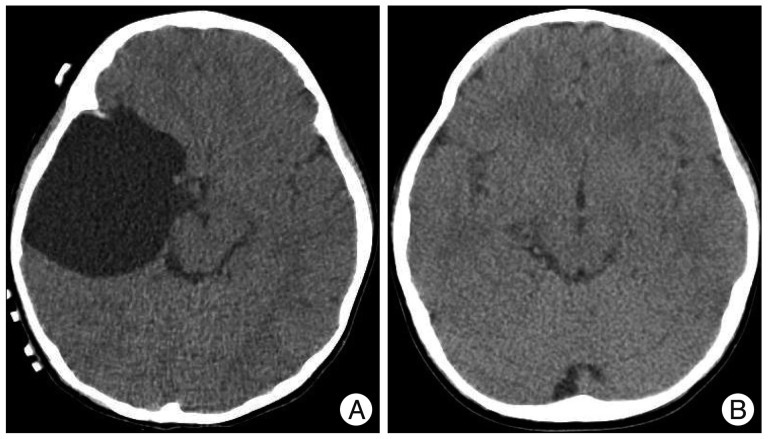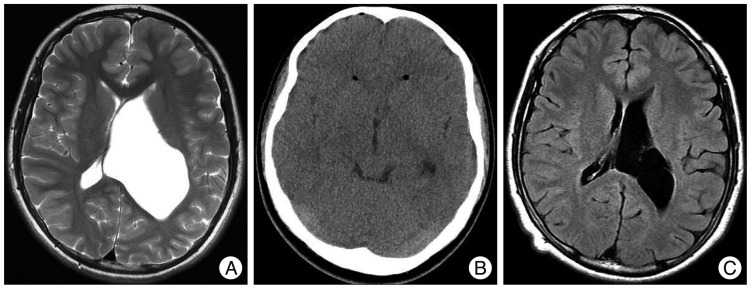J Korean Neurosurg Soc.
2013 Mar;53(3):161-166. 10.3340/jkns.2013.53.3.161.
The Usefulness of Electromagnetic Neuronavigation in the Pediatric Neuroendoscopic Surgery
- Affiliations
-
- 1Department of Neurosurgery, Chonnam National University Hospital and Medical School, Gwangju, Korea. cd1379@naver.com
- KMID: 2190748
- DOI: http://doi.org/10.3340/jkns.2013.53.3.161
Abstract
OBJECTIVE
Neuroendoscopy is applied to various intracranial pathologic conditions. But this technique needs informations for the anatomy, critically. Neuronavigation makes the operation more safe, exact and lesser invasive procedures. But classical neuronavigation systems with rigid pinning fixations were difficult to apply to pediatric populations because of their thin and immature skull. Electromagnetic neuronavigation has used in the very young patients because it does not need rigid pinning fixations. The usefulness of electromagnetic neuronavigation is described through our experiences of neuroendoscopy for pediatric groups and reviews for several literatures.
METHODS
Between January 2007 and July 2011, nine pediatric patients were managed with endoscopic surgery using electromagnetic neuronavigation (AxiEM, Medtronics, USA). The patients were 4.0 years of mean age (4 months-12 years) and consisted of 8 boys and 1 girl. Totally, 11 endoscopic procedures were performed. The cases involving surgical outcomes were reviewed.
RESULTS
The goal of surgery was achieved successfully at the time of surgery, as confirmed by postoperative imaging. In 2 patients, each patient underwent re-operations due to the aggravation of the previous lesion. And one had transient mild third nerve palsy due to intraoperative manipulation and the others had no surgery related complication.
CONCLUSION
By using electromagnetic neuronavigation, neuroendoscopy was found to be a safe and effective technique. In conclusion, electromagnetic neuronavigation is a useful adjunct to neuroendoscopy in very young pediatric patients and an alternative to classical optical neuronavigation.
Figure
Reference
-
1. Abtin K, Thompson BG, Walker ML. Basilar artery perforation as a complication of endoscopic third ventriculostomy. Pediatr Neurosurg. 1998; 28:35–41. PMID: 9693328.
Article2. Aldana PR, Kestle JR, Brockmeyer DL, Walker ML. Results of endoscopic septal fenestration in the treatment of isolated ventricular hydrocephalus. Pediatr Neurosurg. 2003; 38:286–294. PMID: 12759507.
Article3. Barszcz S, Roszkowski M, Daszkiewicz P, Jurkiewicz E, Maryniak A. Accuracy of intraoperative registration during electromagnetic neuronavigation in intracranial procedures performed in children. Neurol Neurochir Pol. 2007; 41:122–127. PMID: 17530573.4. Beems T, Grotenhuis JA. Long-term complications and definition of failure of neuroendoscopic procedures. Childs Nerv Syst. 2004; 20:868–877. PMID: 15197569.
Article5. Buxton N, Macarthur D, Mallucci C, Punt J, Vloeberghs M. Neuroendoscopy in the premature population. Childs Nerv Syst. 1998; 14:649–652. PMID: 9840365.
Article6. Cinalli G, Spennato P, Ruggiero C, Aliberti F, Trischitta V, Buonocore MC, et al. Complications following endoscopic intracranial procedures in children. Childs Nerv Syst. 2007; 23:633–644. PMID: 17447074.
Article7. Clark S, Sangra M, Hayhurst C, Kandasamy J, Jenkinson M, Lee M, et al. The use of noninvasive electromagnetic neuronavigation for slit ventricle syndrome and complex hydrocephalus in a pediatric population. J Neurosurg Pediatr. 2008; 2:430–434. PMID: 19035692.
Article8. Hamada H, Hayashi N, Kurimoto M, Endo S. Endoscopic aqueductal stenting via the fourth ventricle under navigating system guidance : technical note. Neurosurgery. 2005; 56(1 Suppl):E206. discussion E206. PMID: 15799817.9. Hayhurst C, Byrne P, Eldridge PR, Mallucci CL. Application of electromagnetic technology to neuronavigation : a revolution in image-guided neurosurgery. J Neurosurg. 2009; 111:1179–1184. PMID: 19326991.
Article10. Hopf NJ, Grunert P, Darabi K, Busert C, Bettag M. Frameless neuronavigation applied to endoscopic neurosurgery. Minim Invasive Neurosurg. 1999; 42:187–193. PMID: 10667823.
Article11. Lancon JA, Killough KR, Dhillon G, Parent AD. Interventional magnetic resonance imaging guided aspiration and biopsy of a cystic midbrain tumor. Pediatr Neurosurg. 1999; 30:151–156. PMID: 10352419.
Article12. Mascott CR. Comparison of magnetic tracking and optical tracking by simultaneous use of two independent frameless stereotactic systems. Neurosurgery. 2005; 57(4 Suppl):295–301. discussion 295-301. PMID: 16234678.
Article13. McMillen JL, Vonau M, Wood MJ. Pinless frameless electromagnetic image-guided neuroendoscopy in children. Childs Nerv Syst. 2010; 26:871–878. PMID: 20076987.
Article14. Navarro R, Gil-Parra R, Reitman AJ, Olavarria G, Grant JA, Tomita T. Endoscopic third ventriculostomy in children : early and late complications and their avoidance. Childs Nerv Syst. 2006; 22:506–513. PMID: 16404640.
Article15. Rosenow JM, Sootsman WK. Application accuracy of an electromagnetic field-based image-guided navigation system. Stereotact Funct Neurosurg. 2007; 85:75–81. PMID: 17167235.
Article16. Roth J, Beni-Adani L, Biyani N, Constantini S. Classical and real-time neuronavigation in pediatric neurosurgery. Childs Nerv Syst. 2006; 22:1065–1071. PMID: 16761161.17. Sangra M, Clark S, Hayhurst C, Mallucci C. Electromagnetic-guided neuroendoscopy in the pediatric population. J Neurosurg Pediatr. 2009; 3:325–330. PMID: 19338413.
Article18. Scholz M, Hardenack M, Konen W, Fricke B, von During M, Heuser L, et al. Navigation in neuroendoscopy. Minim Invasive Ther Allied Technol. 1999; 8:309–316.
Article19. Schroeder HW, Oertel J, Gaab MR. Incidence of complications in neuroendoscopic surgery. Childs Nerv Syst. 2004; 20:878–883. PMID: 15185113.
Article20. Schroeder HW, Wagner W, Tschiltschke W, Gaab MR. Frameless neuronavigation in intracranial endoscopic neurosurgery. J Neurosurg. 2001; 94:72–79. PMID: 11147902.
Article21. Sieśkiewicz A, Łysoń T, Mariak Z, Rogowski M. [Neuronavigation in transnasal endoscopic paranasal sinuses and cranial base surgery comparison of the optical and electromagnetic systems]. Otolaryngol Pol. 2009; 63:256–260. PMID: 19886532.
- Full Text Links
- Actions
-
Cited
- CITED
-
- Close
- Share
- Similar articles
-
- Intraoperative neurosonography revisited: effective neuronavigation in pediatric neurosurgery
- A Meta-analysis for Evaluating Efficacy of Neuroendoscopic Surgery versus Craniotomy for Supratentorial Hypertensive Intracerebral Hemorrhage
- Effect of Electromagnetic Navigated Ventriculoperitoneal Shunt Placement on Failure Rates
- Stereotactic Endoscopic Evacuation of Intraventricular Hematomas
- A Case of Ruptured Peripheral Aneurysm of the Anterior Inferior Cerebellar Artery Associated with an Arteriovenous Malformation : A Less Invasive Image-Guided Transcortical Approach






